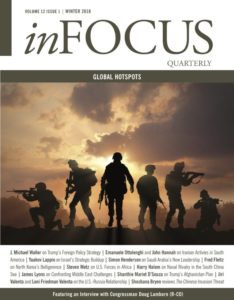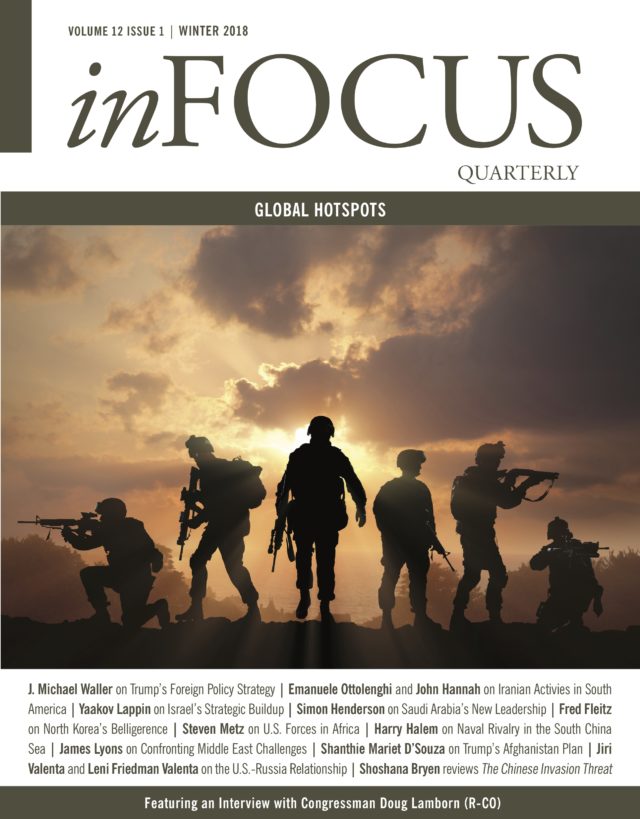by J Michael Waller / InFocus / Winter 2018
With global conflicts stretching the United States toward the breaking point, many feared that the world’s only superpower in 2017 was headed over a cliff.
Flailing policies in Afghanistan stole hard-fought American military gains and had made the Taliban enemy a player again. Things became even worse in Iraq, with ISIS jihadists forming their own caliphate in the north and into Syria, and the Islamic Republic of Iran conquering much of the rest of Iraq, including co-opting the U.S.-installed government in Baghdad. Iran not only built ballistic missiles and probably an atomic bomb, but received pallets of cash from Washington in the process – and now, as we are learning, a free pass for Hezbollah as part of the deal. North Korea proved its capacity with successful ballistic missile launches and underground nuclear tests.
Communist China built militarized reefs in international waters, hacked into the U.S. Office of Personnel Management records and stole the most personal details of every American who had applied for a security clearance, and embarked on an aggressive strategic nuclear weapons upgrade. Vladimir Putin’s Russia unveiled a new generation of strategic nuclear warheads and delivery systems without a peep of protest from Washington, indirectly had paid the husband and family foundation of a sitting secretary of state, shot down a Malaysian jetliner during its invasion and annexation of parts of Ukraine, and openly threatened NATO allies with subversion and destruction.

Chinese espionage and influence operations are so vast that nobody in the U.S. can seem to keep track. Russia’s aggressive intelligence collection and operations against the United States exceeded Cold War levels. Trans-national crime cartels, narcotics smuggling, human trafficking, child warriors, weapons proliferation, and other nightmares suddenly made Honduras and Peru, Uganda and Chad, Pacific Island microstates and other backwaters compelling national interests as illegal immigrants by the millions flooded the United States with impunity.
The Pentagon’s 388-page Dictionary of Military and Associated Terms didn’t even have a definition for “victory.”
Without defining victory, the United States operated almost 800 military facilities in 70 countries and territories in 2015. They ranged from giant bases like Okinawa to small “lily pads” in Burkina Faso, according to a study by American University Professor David Vine. The annual cost is estimated at between $245 and $300 billion. One of those bases, Al Udeid, Qatar, is a vital hub for the U.S. Central Command (CENTCOM), which leads most of the fight against the very terrorists that the Qatar regime is indoctrinating and funding.
Russian, Chinese, and other unfriendly interests infiltrated the leadership and bureaucracies of the great multilateral organizations created and mostly funded by the United States and its closest allies, including the World Bank and International Monetary Fund, both based just blocks from the White House.
This was the background to outsider Donald Trump’s transition to the presidency. Trump arrived at the White House doubly handicapped: He had trouble building a cohesive national security team and remained dogged by allegations that he or members of his inner circle had “colluded” with the Kremlin to win the 2016 election, along with some KGB hacking of electronic voting records.
The allegations seemed serious, considering the source: leaks and later public statements from senior officials in the FBI, CIA, and Director of National Intelligence. The Trump team did a poor job addressing those allegations. It offered no guiding philosophy or strategy other than to “make America great again.”
In inheriting the mess left by his predecessor, president Trump offered little concrete assurance that he would really fix things.
To this day, dozens of senior presidential posts remain unfilled in the State Department, Justice Department, and Pentagon. Trump’s first team under National Security Adviser Michael Flynn blew apart before it could assemble, with a decidedly establishmentarian figure, active duty Lt. Gen. H. R. McMaster, firing most of the Trump loyalists and building a team of Obama holdovers. The strong personality of Defense Secretary James Mattis, a retired Marine four-star general, provided a steady hand that favored Clinton-Obama defense experts anathema to Trump. Secretary of State Rex Tillerson appointed few to carry out his bureaucratic reform objectives, relying heavily on the professional (and very ideological) foreign service and a dumpsterful of Obama loyalists.
For those in the national security and diplomatic fields – even many of his sympathizers and supporters – Trump seemed an unlikely person to come up with a coherent and workable strategy for American world leadership.
Then, days before Congress passed his promised tax reform, Trump released his first annual National Security Strategy. Brash Trumpian rhetoric that espoused vague notions of American greatness coalesced December 18, 2017 into a thoughtful, purposeful roadmap. An “America First” strategy suddenly didn’t seem so extreme, even though it was unabashedly Trumpian.
Business Experience and Personal Leadership
Trump either didn’t bother, or more likely was not prepared, to reorganize his government and appoint MAGA people to senior posts before he grew his presidential worldview. He used the theatrical power of his strong personality as a blunt instrument, yet did so with surgical precision. It was almost as if he didn’t need his (overwhelmingly unsupportive) diplomats to nuance his statements with the wishy-washy “what the president meant to say was”-type comments.
The president had hybridized the bully pulpit. He merged fellow populist Theodore Roosevelt’s style, when “bully” meant “beautiful” or “wonderful” – two of Trump’s favorite adjectives – with the modern sense of using intimidation or psychological force. CONTINUE to the full article.
